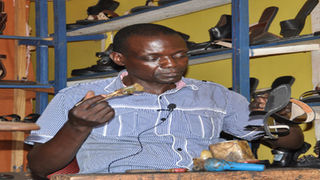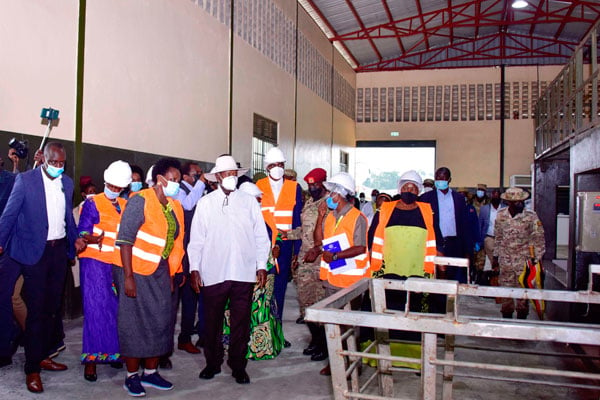
John Byabashaija, the managing director at Web Shoes. Mr Byabashaija says each square feet of wet blue leather is sold at Shs1,000. PHOTO / FILE
Prosper
Prime
How Uganda donates revenue in semi-processed leather
What you need to know:
- 95 per cent of hides and skins are exported as partially processed leather (wet blue) as tanneries operate at 50 to 70 per cent capacity.
Despite Uganda hides and skins being naturally of high quality, high texture and heavy substance which are suitable for the production of excellent heavy upper and vegetable tanned sole leather in East Africa. The quality of leather produced remains low.
Ms Agnes Kitumba, the chief executive officer of Seko Designs, and an exporter of leather products to the American market says, they would have loved to use Uganda made leather, but because of its low quality, they were forced to import good quality leather from countries like India, Turkey, Ethiopia and Italy to make their products for export.
She expounds that this all goes back to the quality of raw materials that Uganda tanneries or entrepreneurs are putting into the manufacturing process of leather.
Saul Kityo, the lecturer at Kyambogo University in the Faculty of Science in the new Department of leather and textile, attributes the low quality of leather to laxity in the care for the animals at the farms, the way they are slaughtered and the way they preserve hides and skins.
Mr Kityo asserts that, on average, if all the necessary processes are followed, a Ugandan hide weighs 16 kilograms and has 29 feet in width which about 15 to 20 per cent, can be used for upholstery. This makes Uganda the only country in East Africa with larger quantities of hides that are suitable for upholstery.
He says at the farm, the skin or hide shouls also be natured, and Uganda animals have a good quality structure skin because of the abundant grass the country has. But the animal is not given proper animal husbandry because nobody is talking about the skin.
But the care for animal skin used to be done when there was a structure. “It was called hides improvement officers in the Ministry of Agriculture, Animal Industry and Fisheries (MAAIF), which was phased out”.
“People only care about the meat but not the skin even in slaughterhouses. There are so many fray cuts by unskilled frayers made on the skin in the abattoir, people learn on the job, they are not skilled and some deliberately leave meat on the skins, because they want to sell it elsewhere and when removing the meat, they damage the skins,” he says.
Mr Kityo explains that even at the farm, there are scratches on animal skins from barbed wire, whip lashes on animals and disease that animals suffer and go untreated.
He says the skin is a highly priced commodity when it goes on the market. In the early 90s, Uganda used to export 100 per cent of raw hides and skins and it was a deliberate effort by the government and the private sector, to put a tax on the export business. So investors set up tanneries. Uganda has about eight tanneries which mainly process to a semi-finished product called wet blue, but does not go to a finished product.
In terms of market value, Mr Kityo says, if you finish at wet blue, you get four times the cost and when you get a finished leather, you get eight times. So we lose much if we do not finish our leather. When you make a shoe or bag, you get 12 times the cost of a raw hide.
He notes that government should puts measures to improve the quality of raw material, like reinstating hide improvement officers at the Ministry of Agriculture to look at how hides are prepared, until they reach the tanneries.
Mr Kityo also emphasizes that in the tannery, we need to have skilled labour. Before mentioning that Kyambogo University, endorsed a course that will bring in knowledge to work in the tanneries and produce quality products.
He, however, notes that still the course is hampered by lack of practical work, because there is not much infrastructure to practically train the students in leather making, so that when they go to the tanneries, they are able to produce quality products.
Harrison Ndung’u, a leather value chain and tannery expert at the African Leather and Leather Products Institute (ALLPI), hinted on a need for the tanneries in Uganda to upgrade technology.
Mr Ndung’u says there are stringent restrictions about the environment. So there is need for Uganda to get state of the art technology to limit environmental pollution and meet the current trends of what is required in the market.
“There is a need to invest in technology especially finishing leather from wet blue to finished product. So that we can compete and earn that money since Uganda has a good quality raw material,” Mr Ndung’u says.
He says the COMESA department of ALLPI is training artisan, MSMEs and University students to do value addition on hides and skins using tanning agents of plant origin as it is positioned as more environmentally friendly and a way of improving Uganda’s leather industry.
“We have discovered that there is a lot of raw material in Uganda and she is also blessed with labour. But most of these raw materials are exported in raw form and we keep on saying that we are not creating jobs for youth. We want to go to the grass root because most of the leather sector is left to foreigners but we need leather,” Mr Ndung’u says.
Instead of relying on the big tanneries people can do it in their households, the challenge is if one goes to those big tanneries and they need a small quantity of leather, like 200 square feet, the industry will decline and say it only sells in bulk. Many Ugandans cannot afford this. He says the leather tanned using agents of plant origin, is not so different from that leather produced in commercial tanneries.
Breakdowns
John Byabashaija, the managing director at Web Shoes, says the process of leather making starts with going to the abattoir, each skin costs Shs2,500 in its raw form. After going through different tanning processes, leather is processed.
Mr Byabashaija says if this piece is tanned to make wet blue leather it produces roughly 5 square feet of wet blue leather. Each square feet of wet blue leather is sold at shs1000, meaning the whole piece can make Shs 5,000.
“Most tanneries in Uganda export at this level, donating revenue and jobs.If the wet blue leather is further processed to produce finished leather, each square feet of finished leather is sold at Shs6,000, meaning the whole piece can now make 5 square feet, each square foot at Shs6,000 making Shs30,000,” he says.
He says if 5 square feet of finished leather is further converted to shoes it makes two pairs, each being sold at Shs 150,000 so two pairs are sold at Shs300,000. Out of Shs2,500, as the initial purchase capital, you used to get the raw skin.
Mr Byabashaija says there is a lot of profit after tanning and that when you add value to make the final product, those off cuts are used to make key holders, watch straps among other items. You don’t lose any piece of leather out of the skins we have tanned.
He says Uganda misses out on employment to Chinese, Indians and Italians when we export wet blue leather whereas Ugandans are lacking jobs. Now that we can make final products we shall employ Ugandans.
Potential
Uganda has potential to get hides and skins from 14.4 million cattle, 16 million goats and 14.3million sheep.
However, the potential available raw material for hides and skins is from nearly 1.5million cattle, 3.1 million goats and 0.6million sheep.
95 per cent of hides and skins are exported as partially processed leather (wet blue).Tanneries are operating in Uganda at 50 to 70 per cent capacity range.





